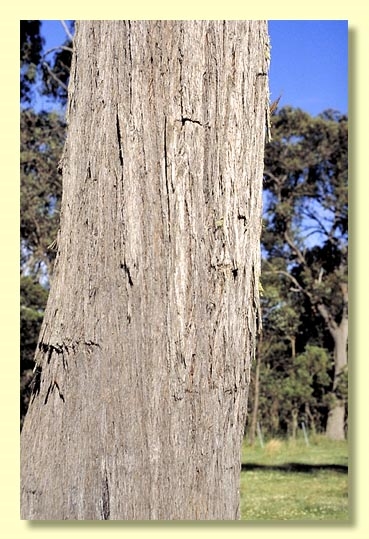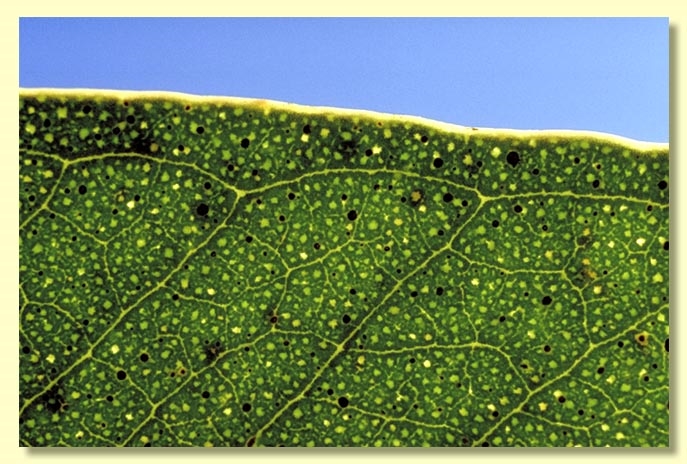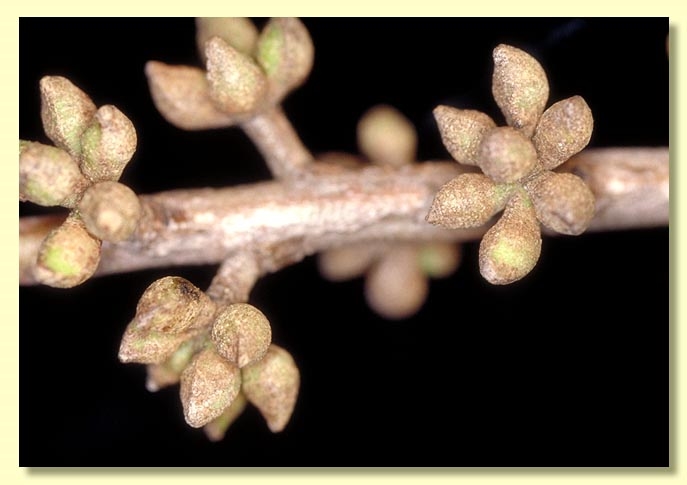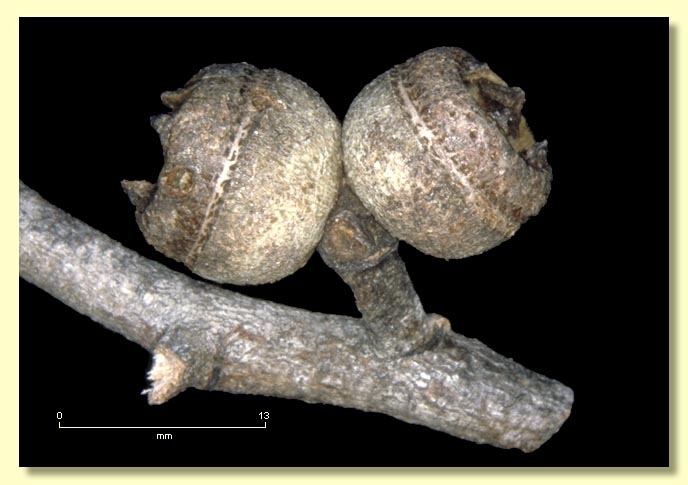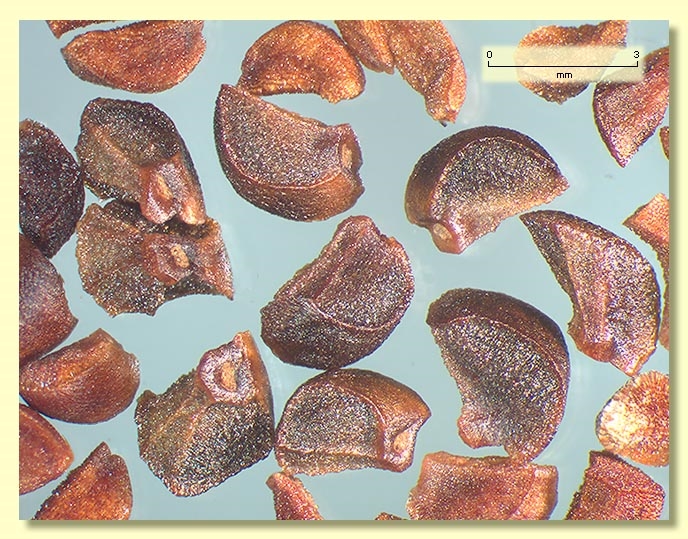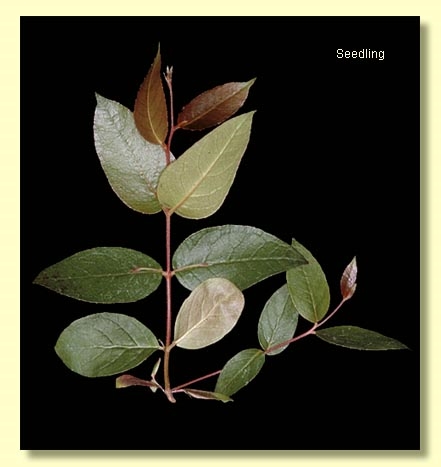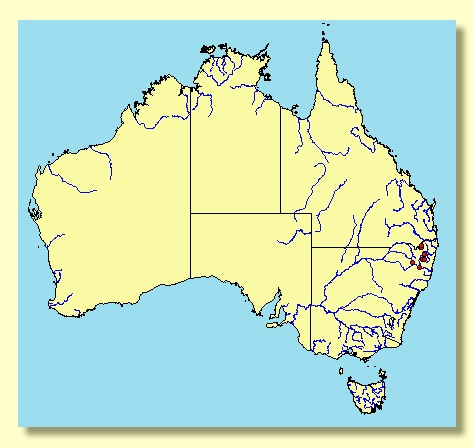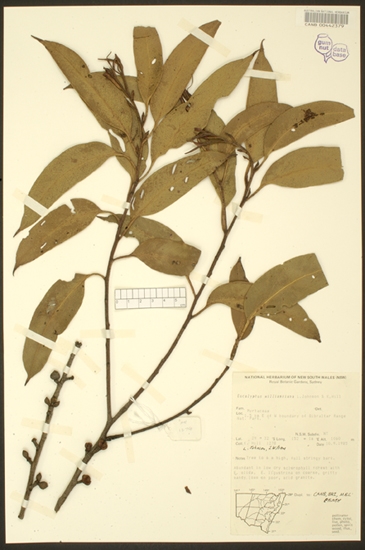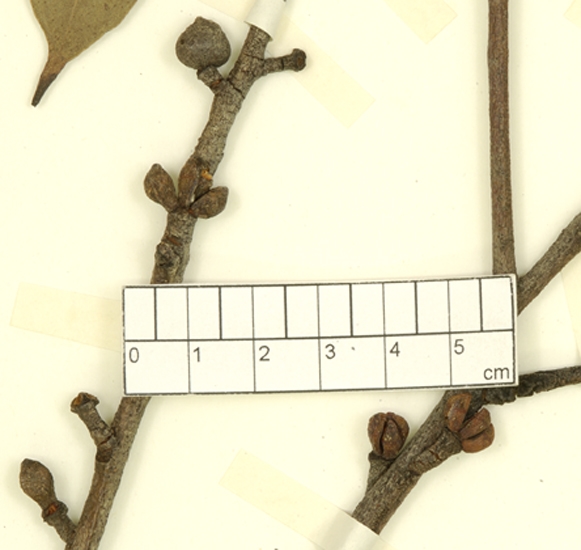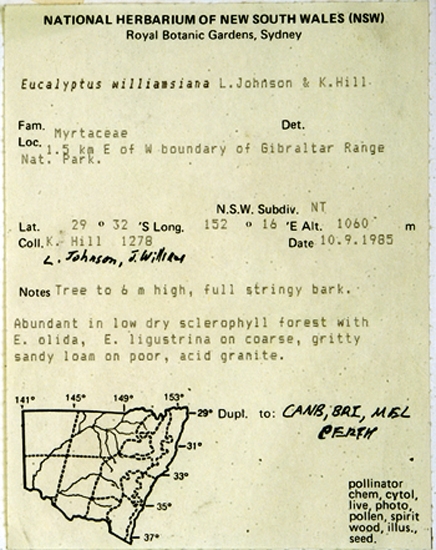Euclid - Online edition
Eucalyptus williamsiana
Eucalyptus | Eucalyptus | Capillulus | Pachyphloius
Tree to 20 m tall. Forming a lignotuber.
Bark rough throughout, coarsely stringy, grey to grey-brown and deeply furrowed.
Juvenile growth (coppice or field seedlings to 50 cm): stem rounded in cross-section, scabrid at first; juvenile leaves sessile or shortly petiolate, opposite for 4 or 5 nodes then alternate, ovate to elliptical, 6–12.5 cm long, 3–7.5 cm wide, base tapering to petiole, discolorous, scabrid on petiole, underside and margin for up to ca 10 nodes but later leaves concolorous, glossy, green, thick, glabrous.
Adult leaves alternate, petiole 1.5–2.7 cm long; blade broadly lanceolate to falcate, 9–18 cm long, 2–5 cm wide, base oblique, concolorous, glossy, green, side-veins at an acute or wider angle to midrib, sparsely to moderately reticulate, intramarginal vein parallel to and well removed from margin, oil glands island, slightly irregular.
Inflorescence axillary unbranched, peduncles 0.5–1 cm long, buds 7, sessile or on pedicels to 0.2 cm long. Mature buds ovoid to fusiform, 0.7–1 cm long, 0.5–0.6 cm wide, green, with longitudinal ridges, scar absent, operculum conical, stamens irregularly flexed, anthers reniform to cordate, versatile, dorsifixed, dehiscing by confluent slits, style long, stigma tapered, locules 3 or 4, the placentae each with 2 vertical ovule rows. Flowers white.
Fruit sessile, hemispherical, 0.5–0.8 cm long, 1–1.5 cm wide, disc raised-convex, valves 3 or 4, near rim level.
Seeds brown, 1.5–2.5 mm long, pyramidal or obliquely pyramidal, dorsal surface smooth, hilum terminal.
Cultivated seedlings (measured at ca node 10): cotyledons reniform; stems rounded in cross-section, stellate-hairy at least on the lower internodes; leaves opposite, subsessile to shortly petiolate and discolorous for ca 4 or 5 nodes then becoming alternate, ovate, 8–11 cm long, 4–6 cm wide, base rounded, margin irregular or entire, apex pointed, lamina more or less glabrous after alternation and concolorous, glossy, bright green.
Flowering has been recorded in January, February, May and August.
A small to medium-sized tree of the eastern side of the Northern Tablelands of New South Wales north from Niangala and Yarrowitch, extending just into Queensland in the Wallangarra district. Eucalyptus williamsiana is fully rough-barked and has a glossy green crown, angular buds and sessile flat-topped fruit 1–1.5 cm diameter. Juvenile growth is scabrid/hairy only on the lower part with upper leaves glabrous, glossy green and ovate to elliptical, 3–7.5 cm wide.
Eucalyptus williamsiana grows in an area where there are eleven other stringybark species, but the size of the fruit and the coarseness of adult and juvenile foliage separate it easily from most of these. It is most closely related to E. youmanii, which usually has shortly pedicellate (not sessile) buds and fruit, the fruit being 0.7–1.3 cm wide, and usually narrower juvenile leaves 1.5–4 cm wide. Another tablelands stringybark, E. laevopinea, has fruit of similar size range (being 0.8–1.5 cm wide) but they too are also usually pedicellate, and in addition it differs in having smooth-barked branches and juvenile leaves 1–4 cm wide. Other stringybark species in this area always have fruit smaller than E. williamsiana .
Very recently a new stringybark, E. boliviana, has been described from the Bolivia Hill Nature Reserve on the Northern Tablelands of New South Wales. It is closely related to E. williamsiana, differing in having quadrangular, winged, glaucous branchlets and glaucous buds and juvenile growth (branchlets rounded and non-glaucous in other stringybarks).
Eucalyptus williamsiana appears to have become weakly naturalized at a single site near Googong on the Southern Tablelands of New South Wales, on granite with new seedlings establishing adjacent to a stand of old planted trees.
MORE ABOUT STRINGYBARKS


